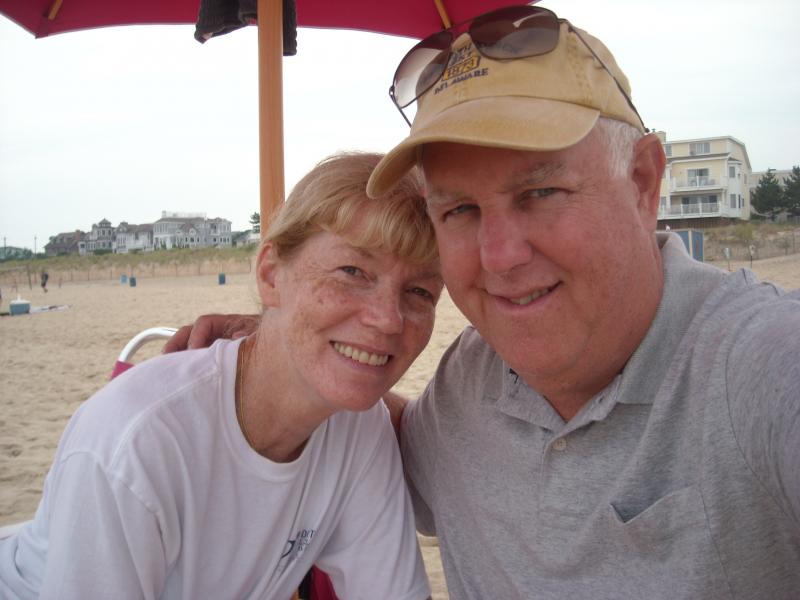Beebe provided extraordinary care for my wife
Beebe Healthcare didn’t save my wife. No hospital in the world could have. A few weeks before Christmas, my wife Darlene lost her appetite to eat, began experiencing stomach pains and cramps, and lost 14 pounds. On Dec. 26, I took her to the Beebe Healthcare Emergency Room where she immediately received a CT scan and was diagnosed with Stage IV Metastatic Liver Cancer. Ten days later she was dead. She had just celebrated her 64th birthday Dec. 20.
But this article is not about Darlene. It is about Beebe Healthcare. I feel compelled to describe the extraordinarily competent and compassionate care that Darlene received during her eight-day stay in Beebe before she was transported via helicopter to Thomas Jefferson University Hospital’s neuroscience center to treat her stroke conditions. Let me be clear, no one at Beebe Healthcare has asked me to write this article. It is an unsolicited testimony to the exemplary healthcare that our local hospital - Beebe Healthcare – provides.
I am using a well-known communication tool that healthcare workers use to convey critically important information in a standardized way. It’s called an SBAR (Situation, Background, Assessment, and Recommendation).
Situation
Between Dec. 26 and Jan. 2, Darlene Mowll received care as an inpatient at Beebe after being admitted to the Emergency Department with stomach pains, abdominal cramps, loss of appetite, and referred pain in the back. Darlene was treated there, transferred to 2 Lynch, and later transferred to the Intensive Care Unit. Darlene was first diagnosed with Stage IV Metastatic Liver Cancer with the primary source of the cancer later clarified by biopsy to have originated in the gastrointestinal tract. She suffered several small strokes and a massive stroke Jan. 2. Darlene passed away Jan. 5 from metastatic adenocarcinoma and cerebral infarction.
Background
I know something about the quality and safety of hospital care. While I am not a clinician, I enjoyed a 40-year career in healthcare including 20 years as an executive vice president of The Joint Commission (Oakbrook Terrace, Illinois) - the agency that sets the standards for hospital quality and safety and evaluates the hospital’s compliance with those standards. Beebe Healthcare is Joint Commission accredited. I specialized in high reliability and patient safety, and have authored a book on these subjects titled “The Five Disciplines for Zero Patient Harm - How High Reliability Happens,” to be published by the Health Administration Press this spring.
Darlene was a Registered Nurse and had worked in several hospitals over the years. We have only lived in the Lewes area for three years, although I grew up in Rehoboth, and we vacationed in the area for many years. Darlene didn’t think much of Beebe, viewing it from a distance.
From the outside, Beebe doesn’t compare to some of the world-class hospitals we were used to in the Chicago area where we had lived for over 20 years. On three different occasions during her stay in the hospital, Darlene said, “I was wrong.” She complimented the nurses for their responsiveness and caring attitude. She appreciated the clinical competence and attention to patient safety that the staff exhibited. And she benefited from the rapid communications and decision-making between nursing staff and the hospitalists on duty.
Darlene’s condition got worse every day she was in the hospital, notwithstanding the extraordinary efforts by a great team of clinical and non-clinical experts who tried to do the best they could for a patient reeling in agony from the pain of Stage IV metastatic liver cancer, the adenocarcinoma that originated in her intestinal tract, and later strokes.
Assessment
The following describes 10 things you should know about Beebe Healthcare that you may not know or did not fully appreciate during your visit to the hospital. These are the things that hospitals on the quest for high reliability (consistently safe care for every patient, every time) do to protect patients from preventable harm and to provide an excellent patient care experience.
In Beebe Healthcare’s own words: “Do what it takes to keep everyone safe. Do it right the first time, every time.” I provide this summary assessment based on my extensive experience in high reliability organizing and patient safety.
AIDET: I watched as many patients and visitors walked the hallway next to the gift shop and the Sunshine Café passing by Beebe’s “Performance Improvement” display board without giving it even a glance. Too bad. Beebe’s Measures of Success and behavioral expectations for all staff are clearly described on this public display.
And guess what? Beebe’s caring staff “walk the talk.”
The AIDET framework involves 1) Acknowledging and greeting the patient by name, 2) Introducing yourself - whether a nurse or physician or other caregiving staff, 3) Duration of the test or process is described along with next steps, 4) Explanation is provided to the patient of every step and what to expect next and who to contact with any questions, and 5) “Thank you” is expressed to the patient and family for their communication and cooperation.
This guidance to staff from leadership sets the tone and behavioral expectations for all staff and at Beebe; it was witnessed in the performance of every caregiver we encountered.
Great Catch Award: Hospitals that are in pursuit of the high reliability goal of zero patient harm from either human error, systems errors, or human factors train nurses, doctors, and other caregiving staff to have a strong sense of situational awareness, looking for things that might go wrong. Staff are trained to catch an emerging threat to patient safety before it can harm the patient. Beebe rewards its staff for Great Catches, and this is an exemplary practice of leading hospitals.
Handwashing: I spent 12 to 15 hours a day at my wife’s bedside and witnessed, I will estimate, over 260 caregiver encounters with my wife whether it was to ambulate her, change her IV nutrition and medication regimen, visits from the hospitalist on duty, visits from other clinical specialists, transport personnel to take her for a test, or occupational and speech pathology exercises.
I observed 100 percent “wash-in, wash-out” compliance. Maybe they knew I had previously worked for the joint commission, but it looked like a well-established and consistent practice to me. Why is this important, you might ask? What’s the big deal with handwashing? According to the Centers for Disease Control and Prevention, washing hands saves lives. Hands carry germs and when patients are in the hospital, they are more susceptible to infection which can prolong their hospital stay or even lead to the serious consequences of infection, even death.
Fall prevention: Safe hospitals use multiple, independent “defenses” to protect patients from harm. Safe hospitals like Beebe employ a variety of redundant “defenses” to prevent a patient from falling and getting hurt, further exasperating their condition. Posted in the ceiling tiles above every patient bed in bright yellow (not to be missed as the patient is lying in bed) are signs advising “Don’t Get Up Without Us. Call, Don’t Fall.”
Hospitalists: According to the Society for Hospital Medicine, hospitalists promote exceptional care for the hospitalized patient. Hospitalists focus on general medical care of the hospitalized patient, spending most of their time in the hospital, and therefore are readily available to direct or respond to a patient’s care needs. Not all hospitals have hospitalists - Beebe, fortunately, does. They were an extraordinary help in managing Darlene’s condition that literally took a change for the worse every day presenting a new set of challenges for all of the caregiving staff.
We encountered the clinical excellence of Drs. Michael Cortes, Sravanthy Pataparla, Madhu Prattipati, and Binzhi Zhang. Dr. Zhang led the Rapid Response Team on the first of Darlene’s “crashes” in condition, a sudden and near-fatal drop in blood pressure. Thank you, doctors, for your clinical excellence and attention to Darlene’s medical care in her last few days of life.
Daily Report Out: High performing, highly reliable organizations that have a strong focus on safety monitor recognize improvement in reducing the most serious threats to safe performance. In the case of hospitals, the goal is consistently safe, harm-free patient care. Beebe posts their “Number of Days Since” statistics for major safety threats including patient falls, catheter-associated urinary tract infections, and central line-associated bloodstream infections. The results I saw for the unit Darlene was on were impressive - no CAUTI or CLABSI for over a year.
Remarkable effort and results!
Medication management: medication errors, giving the patient the wrong medication or in the wrong form or amount, have been a persistent safety challenge in hospitals forever. But there are proven protocols, steps to take, and procedures to follow that will either prevent the mistake from happening or mitigate the untoward effects of the error. I observed several state-of-the-art safeguards and defenses that Beebe nurses employed to make sure that the right drug, in the right dose and route, was administered for the right patient.
Patients and families are encouraged to “Ask 3” questions about the drugs they are about to be given: what is the name of the drug, what is it used for, and what are the potential side effects. Most of the time, we didn’t have to ask; the nurse volunteered the information. Nurses used bar code medication administration to make sure the right patient is getting the right medication and used peer double checks where one nurse will confer with another nurse to verify the administration of high-risk, high-alert medications.
Clinical communications: when the condition of the patient can change rapidly based on the illness, treatment, or medications, the timeliness of communication between the nurses, physicians, and other caregivers is vitally important. “Delay in treatment” has been identified by the joint commission as one of the major causes of serious safety events in hospitals.
I was extremely impressed with how fast the nurses were able to communicate a change in Darlene’s condition to the hospitalist on duty and how fast the hospitalist either responded electronically or appeared in person. Beebe utilizes “Perfect Serve” technology on their portable Workstation on Wheels (WOW) that are taken right into the patient’s room to enter patient information and to correspond with the physician in charge of her care. Remarkable!
RRTs (when things go really wrong): Rapid Response Teams are summoned to appear quickly at the patient’s bedside when something really bad occurs in their condition, I don’t know how else to say it. The patient is in a life-threatening situation. In Darlene’s case, an RRT had to rush to her aid on two occasions, once when her blood pressure plummeted, and once when she suffered a massive stroke. I believe that Dr. Zhang led both teams. I don’t know all of your names, but thank you for your clinical competence and compassion, and Dr. Zhang, for your stellar leadership. Darlene loved the nurses, and for good reason.
The nurses did everything they could to make Darlene as comfortable and painfree as they could. Mel Walls, RN, and Lydia Marin, RN were especially caring, competent, and compassionate. Ms. Walls was always cheerful, which made Darlene feel better and happier, despite her fate. Ms. Walls said that she sees every patient “as family” which was evident in the wonderful nursing care she provides. Darlene also called Jen (didn’t get her last name) a “Star Nurse” for her caring approach. A Daisy recipient Ms. Walls, Jen, and Lydia Martin should be!
Recommendations: Contrary to Beebe Healthcare’s three-pronged approach to seeking high reliability in the care they provide, high reliability is not based on a culture of safety, robust process improvement, and leadership for safety. Yes, board and senior leader commitment to the goal of zero patient harm is a strong driver of a consistently safe care environment, but high reliability is achieved through action and changing at-risk behaviors to safe behaviors for all staff. Beebe Healthcare, in my expert opinion, is well on the way to becoming a high reliability organization because it has been able to effectively change behaviors, and those new safe behaviors have become good habits.
Congratulations, Mr. Fried and the entire Beebe Healthcare team!
Chuck Mowll, LFACHE, is president/CEO of the Patient Safety Coaches Academy.





















































